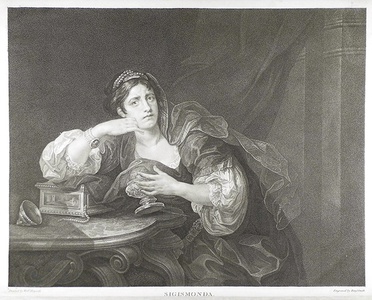| Method | Stipple |
| Artist | Benjamin Smith after William Hogarth |
| Published | Painted by Willm. Hogarth. Engraved by Benjn. Smith. [Published June 4. 1795, by J. & J. Boydell, at No,, 90, Cheapside; & at the Shakespeare Gallery, Pall-Mall.] |
| Dimensions | Image 325 x 418 mm, Sheet 350 x 442 mm |
| Notes |
A stipple engraving by Benjamin Smith of Hogarth's original oil painting of Sigismunda, commissioned by John and Josiah Boydell for their editions of Hogarth's complete works. Hogarth's Sigismunda was intended to be the grandest example of Hogarth's ability as a heroic painter, which he hoped would prove the merit of modern British art when compared to the Old Masters. The painting was advertised using the subscription ticket 'Time Smoking a Picture,' a clear demonstration of Hogarth's challenge to the supposed primacy of the ancients. Unfortunately the painting was heavily criticised, and Hogarth was so dispirited as to almost give up painting entirely. The scene is taken from Boccaccio's Decameron. Sigismunda, dressed in a veil, heavy long-sleeved dress, and pearls, has just received delivery of a golden goblet, which houses the heart of her husband, Guiscardo. Her father, Prince Tancred, disapproving of her marriage to a man of such low birth, has had her lover executed, the horrible gift a signal of his anger. Benjamin Smith (1754-1833) was a British engraver, printseller, and publisher. A student of Francesco Bartolozzi, his most celebrated engravings were the series he undertook for Boydell's editions of Shakespeare and Milton, though he also produced many fine plates after William Hogarth and George Romney, as well as portraits of George III. William Hogarth (1697 - 1764) was born in London, the son of an unsuccessful schoolmaster and writer from Westmoreland. After apprenticeship to a goldsmith, he began to produce his own engraved designs in about 1710. He later took up oil painting, starting with small portrait groups called conversation pieces. He went on to create a series of paintings satirising contemporary customs, but based on earlier Italian prints, of which the first was The Harlot's Progress (1731), and perhaps the most famous The Rake's Progress. His engravings were so plagiarised that he lobbied for the Copyright Act of 1735, commonly referred to as 'Hogarth's Act,' as a protection for writers and artists. During the 1730s Hogarth also developed into an original painter of life-sized portraits, and created the first of several history paintings in the grand manner. Condition: Excellent impression, small hole to top left of image, trimmed within the plate just below title with false bottom margin added. |
| Framing | unmounted |
| Price | £100.00 |
| Stock ID | 38151 |

